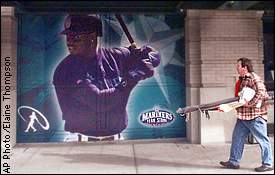| | SEATTLE -- The House That Griffey Built won't be home to
Junior anymore.
|  | | Ken Griffey Jr. left his stamp on Seattle's sports psyche. |
The glorious Ken Griffey Jr. era in Seattle ended Thursday when the Mariners traded away the player they took with the No. 1 pick in the 1987 draft to the Cincinnati Reds.
"We might not have baseball here right now but for Ken and we
might not have Safeco Field," team president Chuck Armstrong said.
"So we shall we forever indebted to him and all of his
contributions.
"We hope that when he thinks about it, he goes into the Hall of
Fame in a Mariners uniform," Armstrong said.
For the greatest player in franchise history, the Mariners got
pitcher Brett Tomko and center fielder Mike Cameron, infield
prospect Antonio Perez and minor league pitcher Jake Meyer.
"I wouldn't know our new players if they walked in the room,"
Armstrong admitted, "but I think we got four pretty good
ballplayers."
No one, though, may ever replace the aura Griffey brought to town.
Even when the Mariners suffered through losing seasons the past
couple of years, they were still wildly attractive to Seattle fans.
Griffey's dramatic home runs, brilliant defense in center field and magnetic smile were enough to draw crowds -- both at home and on the road -- even when the Mariners' pitching and defense weren't.
Alex Rodriguez and the departed Randy Johnson were part of the Mariners' success that led to the building of Safeco Field, their new $517.6 million outdoor stadium that insures they will remain in the Northwest.
But the Mariners have been Griffey's team for a decade.
Griffey played only 42 games in the new park, which opened last July. Chances are, fans will see him make a return appearance when Seattle plays host to the 2001 All-Star game.
"He did a lot for Seattle. He helped us get Safeco Field," said Chris Lufty, 34, a sales clerk at Sports Den, a Mariners merchandise store.
Griffey did not really appear to like Safeco Field, one of the reasons why he might have wanted out of Seattle. He did not complain publicly, but made it clear he didn't like the new ballpark's larger-than-the-Kingdome dimensions and the heavy outdoor, sea-level air that cut down his chances to hit home runs.
In building a career will certainly lead him to Cooperstown, the 10-time All-Star hit 398 home runs. At 30, he's considered a threat to break Hank Aaron's record of 755 homers.
For 11 seasons, Griffey gave the Mariners something they didn't
have before he arrived in Seattle in 1989: legitimacy.
On Nov. 2, however, Griffey met at his home in Orlando, Fla.,
with Armstrong, new Mariners CEO Howard Lincoln and new general
manager Pat Gillick. It was then that Griffey told them he wanted a
trade, saying he would agree to play in four cities.
He later changed that to one city, Cincinnati, his old hometown. Whatever leverage the Mariners had was lost.
"If we didn't get something that made some sense for us and fit for us, then we were prepared to go to spring training with Ken," Gillick said. "We were prepared for him to come back."
But in the end, remembering Johnson's bitter lameduck half season with Seattle in 1998, the Mariners made their move.
Mariners fans may have tired of the trade saga in the past few
months. Even so, they're sure to miss Griffey's smile, his sweet
swing and acrobatics in the outfield.
"He was part of the community. He was more than a baseball player," said fan James Aston, 62. "He resembles some of the good spirit that represents Seattle. We could use that kind of positive image."
Six times in their pre-Griffey years, the Mariners drew fewer than 1 million fans a season to the Kingdome, and the scant attendance caused constant talk of moving the team. With Griffey in
their lineup, the Mariners drew nearly 3.2 million fans in 1997 and more than 2 million fans five times.
How bad were the Mariners before Griffey arrived? In their first seven seasons, they lost more than 100 games three times. They didn't have their first winning season until their 15th year, in 1991 under manager Jim Lefebvre.
Lefebvre loved Griffey as a player. Lou Piniella, Seattle's manager the past seven years, loved him even more. Piniella, a pretty good player in his own time, called him "Junior" with a tone of awe in his voice.
In 1995, when the Mariners had a magical comeback season to
provide them with the impetus to get Safeco Field built, Griffey
missed much of the season with a severely fractured left wrist.
He broke both bones in his left wrist when he crashed into the
right-center field wall in the Kingdome while going after a drive
by Baltimore's Kevin Bass in May. Naturally, the player called
"The Natural" by many made an amazing catch.
When the Mariners won their second AL West
championship in 1997, Griffey was the unanimous AL MVP when he hit .304
with 56 homers and 147 RBI. In 1998, he followed that up with 56
homers and 146 RBI.
All told, Griffey played 1,535 games for the Mariners and batted .299 with 1,152 RBI.
"Too bad they built that stadium just for him," said Dan Flannery, 41.
| |
ALSO SEE
Griffey accepts offer, joins Reds
Seattle fans grateful for all Griffey gave them
Neyer: Life goes on in Seattle
Ratto: McGwire revisited
When superstars get traded
How will Griffey hit in Cincinnati?
NL: Griffey must now deliver
Highest baseball salaries
 |


